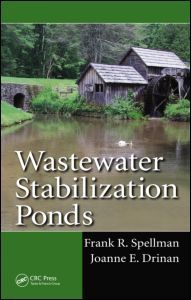Description
Wastewater Stabilization Ponds
Authors: Spellman Frank R., Drinan Joanne E.
Language: English
Subject for Wastewater Stabilization Ponds:
Keywords
Facultative Ponds; Wastewater Stabilization Ponds; facultative; Pond Systems; systems; Wastewater Treatment Pond; treatment; Aerobic Ponds; biochemical; HRT; oxygen; Detention Times; demand; Anaerobic Ponds; anaerobic; Theoretical HRT; hydraulic; Organic Loading Rates; retention; Confined Space; time; Rock Filter; DAF; Detention Time; TKN Removal; Intermittent Sand Filters; NH3 Removal; Wastewater Ponds; Pond Effluent; Hydraulic Loading Rate; Whirligig Beetles; Aerated Ponds; River Pool; Nitrogen Removal; TSS Removal
190.51 €
In Print (Delivery period: 15 days).
Add to cart· 15.6x23.4 cm · Hardback
Description
/li>Contents
/li>Readership
/li>Biography
/li>
Ponds (lagoons) have been used for centuries with great success in the treatment of wastewater. Ponds created for treatment, known as stabilization ponds, model the physical and biochemical interactions that occur in natural ponds. Easy to build and manage, stabilization ponds can accommodate large fluctuations in flow, and provide results that are comparable to conventional systems at a much lower cost. Wastewater Stabilization Ponds examines the use of this natural and highly effective process. The text is centered on wastewater pond management processes and operation procedures that provide passive treatment with a minimum of energy-driven mechanical elements.
It highlights the environmental principles, practices, engineering, and mathematics involved in the design and operation of conventional wastewater stabilization ponds. It also explores the major processes, procedures, and design methods relevant to wastewater treatment ponds. This includes the basic processes, in-pond design evolution and enhancements, oxygen addition, and modifications that require energy, nutrient removal, as well as effluent total suspended solids removal. Emphasizing the design, construction, and operation of wastewater ponds, the book serves as a valuable resource for anyone seeking information on pond construction and operation, knowledge of pond operation, and assistance in certification exam preparation and study.
- Presents a design of wastewater stabilization ponds
- Includes a complete description of pond process elements
- Provides descriptions of pond insect macroinvertebrates
- Incorporates pond morphometry calculations
- Contains extensive pond-related math problems
Sustainability and energy conservation are underlying themes throughout the text and the authors offer valuable information on potential renewable energy sources.
Introduction. Pond Biota. Planning, Feasibility Assessment and Site Selection. Design of Municipal Wastewater Treatment Ponds. Physical Design and Construction. Advances in Pond Design. Nutrient Removal. Upgrading Pond Effluents. Cost and Energy Requirements. Operation and Maintenance.
Frank R. Spellman, PhD, is a retired U.S. Navy officer with 26 years of active duty, a retired environmental safety and health manager for a large wastewater sanitation district in Virginia, and a retired assistant professor of environmental health at Old Dominion University in Norfolk, Virginia. The author/co-author of 92 books, Dr. Spellman consults on environmental matters with the U.S. Department of Justice and various law firms and environmental entities throughout the globe. Spellman holds a BA in public administration, a BS in business management, and an MBA and MS/PhD in environmental engineering.
Joanne E. Drinan
is a retired U.S. Navy chief petty officer with 20 years of active duty. She worked for 13 years as an administrative coordinator for a large wastewater treatment sanitation district in Virginia Beach, Virginia. Currently, Drinan works for a nonprofit organization in Oneonta, New York. She is the author/co-author of more than 12 environmental science books. She holds a BS in business administration from St. Leo University.These books may interest you

Natural Wastewater Treatment Systems 214.69 €



